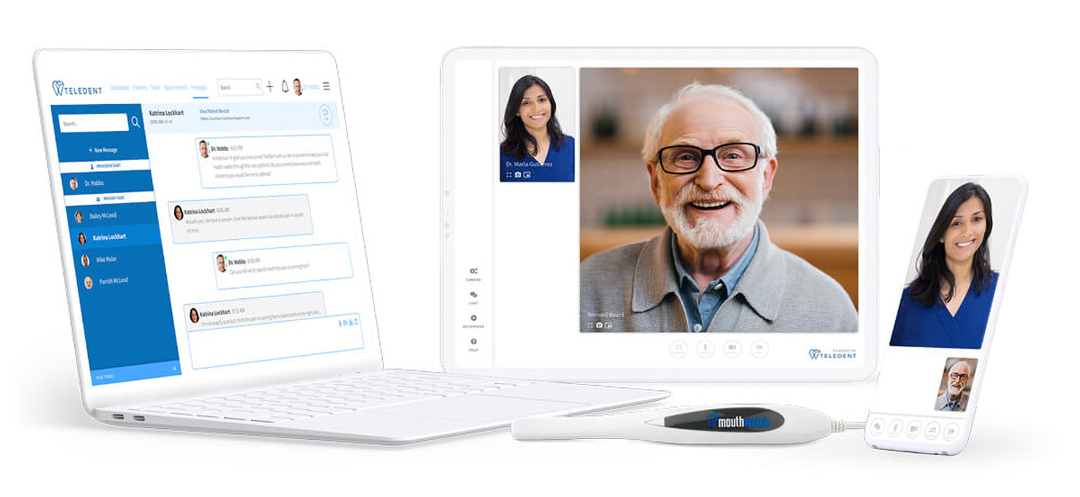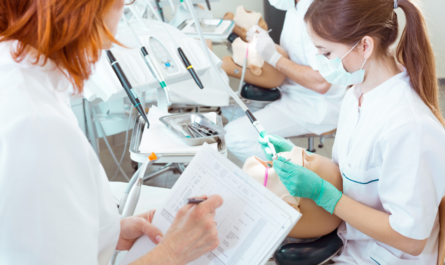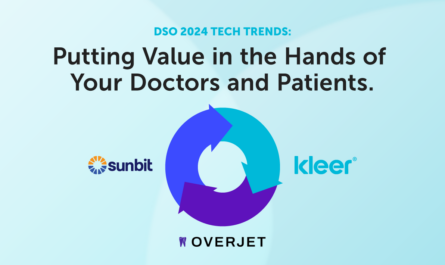Teledentistry is here to stay. What do group practices need to know in order to get started?
In today’s dental practice environment, consultations that used to be simple aren’t so simple anymore. For instance, pre-COVID, how many doctors would go from the restorative operatory to the hygiene operatory for a consultation, and then back again, in the same white coat and little if no PPE? Now the process involves a change of gloves, masks, and gowns – which puts a strain on the doctor’s time, as well as an added cost for PPE exchange.
Fortunately, with the right teledentistry platform, those consults, and other similar interactions, can occur without the dental group practice missing a beat.
Teledentistry has skyrocketed, both in awareness and implementation by the full spectrum of care providers. The pandemic closing and restricting access to physical locations, combined with policies that allowed for easier reimbursement for services provided via teledentistry has brought it out of the innovative dental models and public health programs and into private practices, DSOs and just about every care setting, said Brant Herman, founder and CEO of MouthWatch, makers of TeleDent, a leading teledentistry platform.
“With the COVID inspired implementation of teledentistry, initially for emergency consultations and evaluations, we have now seen practices getting on board with the range of other uses, including intra-office teledentistry to preserve PPE, collaboration with specialists, post-op evaluations done virtually, and many other exciting, time saving and convenient approaches to effective patient care,” Herman said.
Opportunities amid a pandemic
Despite shelter-in-place orders and many businesses shut down, some practices kept in touch with patients by effectively implementing teledentistry during the initial quarantine stage of the pandemic. Through this, they were able to advertise their being open for consultations and emergency evaluations without any risk to their patients and office team. For those requiring visits for emergency treatment, practices could prescribe medications, explain the appointment visit process and make for a more effective follow up without requiring a second visit. They promoted this on social media to their community, not only for emergency consults but also cosmetic consults (to make the most of downtime). They also utilized the platform to have their team look into restorative cases where they may have been a need for follow up.
“Through invitations to the patient portal and scheduled post-op follow ups, the practice generated revenue and reassured patients of their concern and availability,” Herman said. “In some cases, this was home care instruction, product recommendations and more.”
As offices reopened, it became a shift for communications prior to appointments, consultations post appointment, moving periodic exams to the cloud and making things easier for the staff regarding timing, patient exposure and preservation of limited PPE. “This has continued, and practices are now using it for collaboration, more patient messaging and easier communications – meeting the convenience needs that patients are asking for and comfortable with,” Herman said.
Selecting the right teledentistry platform
Mike Uretz is a nationally recognized dental and medical group practice software consultant, educator, and founder of dentalsoftwareadvisor.com. Mike offers the following multi-step process for group practices and DSOs to use when selecting a teledentistry platform.
No. 1: Look for a true teledentistry solution
There is a misconception that dentists can take an off-the-shelf video product, like Zoom or Google Meet, hook it up to a payment bridge, then a scheduling service, and finally 1-2 other software products and cull together a solution for teledentistry. “That’s really unwieldy, especially for a group or DSO, because you have all these disparate applications and nothing talks to a common database,” said Uretz. When you cull together different types of solutions, none of the data is standardized and saved in one place. That’s an issue, especially for a group or DSO.
Some software companies will bolt on something like a videoconferencing solution for a very basic level of teledentistry consult, but teledentistry is much more than that. The video consult is typically referred to as synchronous teledentistry. There’s also the asynchronous part, behind-the-scenes functions. For example, to get ready for a visit, you can take and send images, and then get responses from a provider on the other end. Or you can share notes and information. With asynchronous functions, the general practice dentist can do a consult with a specialist.
“Teledentistry is not just having a video consult one on one between patient and provider, but also the ability to collaborate with other providers on that consult whether using both real-time video and asynchronous processes,” Uretz said.
Group practices should shy away from hooking up numerous disparate applications themselves and trying to make it all work. That’s a recipe for disaster. Uretz said DSOs and groups should also beware of vendors that aren’t really committed to teledentistry and just bolt on videoconferencing to make a buck. That type of application is going to be limited. “I would have a group or DSO focus on looking at teledentistry companies that provide a level of video virtual visits, asynchronous processes, collaboration, document and image sharing and patient engagement and communications. These should all be wrapped in easy-to-use workflows. Also, having helped lead the movement in Dental EHRs these past few years, I very much feel that how a teledentistry solution performs clinical documentation is key. If the teledentistry platform can’t capture clinical documentation and notes very well, then that’s going to be tough and you’re always going to be going back and forth between two applications – your practice management system and teledentistry system. Unless there is a high level of clinical integration between the two.”
No. 2: Processes in evaluation and selection
After years of helping group practices select, purchase, and implement software solutions, Uretz’s clients have learned that instead of just shooting from the hip with no plan, group practices and DSOs would be well served to use more analytical stepwise processes when selecting the right teledentistry solution for their situation. What features and functionality do you want? Are you going to be using it for second opinions from other providers in your office? Are you going to be using it to help with treatment acceptance or patient education? Are you doing case collaboration with your dental and medical colleagues? There are many factors to take into consideration when analyzing your needs.
“Because every group is a little different, every group is going to use teledentistry a little differently,” Uretz said. “And every group probably has innovative ideas for how they’re going to use teledentistry both now and into the future post COVID.”
No. 3: Share your needs in Request For Proposals (RFPs)
The next step in selecting a teledentistry solution would be to take those needs and requirements, – what you’re trying to do, what you expect of a teledentistry solution – and share that in the form of a Request For Proposal with the teledentistry companies. The goal of this process is to filter down from several teledentistry solutions to a smaller, more manageable number which ultimately will streamline the process and save you time. RFPs can be very detailed documents and can take a little time to put together correctly, but none the less are powerful essential tools when trying to make software and IT purchase decisions.
No. 4: Put the vendor demos to the test
Once a group practice has invited a vendor in, the practitioners and team members need to be involved in the demo. Uretz advises his clients to develop cases and scenarios for everyday applications of the product. “In the case of teledentistry, it would be collaboration, virtual consults, second opinions, and various workflows,” he said. “Instead of letting the vendor control the demo and show the group or DSO what the vendor wants to show them, the group or DSO is taking charge of what they want to review. They’re seeing how the particular vendor’s teledentistry solution works with their specific needs.”
Besides features and functionality, other factors to inquire about are how the vendor does implementation and training. And most importantly, how does their support work? Are there support guarantees, known as SLAs? When selecting a teledentistry solution, don’t forget how critical the contract is in these areas.
Newfound expectations
Uretz said he sees a sea change coming with teledentistry in group practices. “I think that teledentistry will be an important part of a workflow of any group or DSO in the future. If I thought teledentistry was just for this COVID era and not a powerful tool for the future, I wouldn’t be spending all the time I have been helping my DSO and group clients evaluate how teledentistry can fit into their overall business strategies.”
For example, the information gathered through a virtual teledentistry visit is going to be critical for knowing ahead of time how to treat the patient. Group practices can diagnose a lot virtually before patients come in. Secondly, the patient becomes more educated. Instead of sitting in the chair and in 30 seconds having to have an interaction, the patient has a chance to think about the information, talk to the dentist or hygienist, and have that discussion before they even come into the clinic.
Herman believes that patients have a newfound expectation of convenience from their provider, and teledentistry will be the key to bringing this convenience to them. “Insurance carriers will see value in the shift of some evaluation services and consultative services to being provided via teledentistry and there will be reimbursement for these consults,” he said. “Additionally, insurance will begin offering these services directly to their members as a value add and tool to drive patients to the physical locations.”
Uretz anticipates more collaboration as a result of teledentistry. This will be especially true as dental medical oral health collaboration becomes more standard in healthcare. With the asynchronous processes where people can share and collaborate with information behind the scenes, now you can bring in all kinds of providers to discuss and make decisions, along with the patient, outside of the context of clinic. The provider can get second opinions, as well as the patient.
Integration with practice management, mobile programs, community outreach and other services that DSOs and groups will be able to capitalize on will become more common, Herman said. These groups will also be able to utilize AI for pre-screening and assessment of teledentistry consultations with a seamless integration into practice management software.
“Because of all these factors, I think the train has left the station,” Uretz said. “As you can see through some of these features and functionality, I think they’ll become staples in the future within a group or DSO and become part of their workflow.”
For more information on Teledent, visit www.mouthwatch.com.
To contact Brant Herman, email him at [email protected] or visit www.mouthwatch.com.
To contact Mike Uretz, email him at [email protected], or visit dentalsoftwareadvisor.com.
Patient and practice benefits of teledentistry
Practice benefits include:
- Convenience for patients
- Billable exams without chair time
- PPE preservation
- Marketing value
- Enhanced collaboration with specialists
- High touch, digital referrals
- Time preservation by shifting certain evals to the cloud (some post op, some periodic exams, case presentations and new patient consults)
- Revenue coming from evaluations
- Efficient scheduling of emergencies
- Supporting patients and improving patient trust
- Improved lab communication
- Messaging that includes patients and/or other specialists
Patient benefits include:
- Convenience
- Access to dental expertise anywhere
- Ability to discuss their treatment without the doctor in a mask, shield, loupes, etc.
- Potential insurance coverage
- Time savings for physical appointments
Features and benefits
Key features that practices need to consider when selecting a teledentistry platform
- Combination of synchronous and asynchronous messaging – many cases can be handled without live video
- HIPAA and enterprise security
- Video conferencing with recording capabilities and snapshots saved to patient records
- CDT Code capturing and reporting
- Multiparty/multi-camera video conferencing
- Screen sharing
- Integration and roadmap for PM integrations
- SMS notifications
- Patient education presentation
- User friendly multi-party collaboration
- Streamlined patient engagement and communication workflows
Functionalities that specifically benefit groups and DSOs
- Top tier security
- Practice/User/Data management and siloing (eg: provider and patient in practice #1 aren’t seen by provider in practice #2, unless we want them to see them)
- Multi-party chat and video
- Recording and archiving of video and images
- Integrations
- Custom development capabilities





